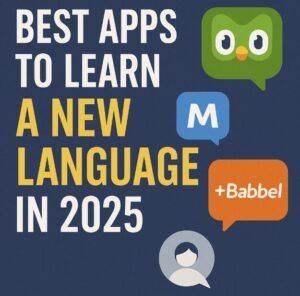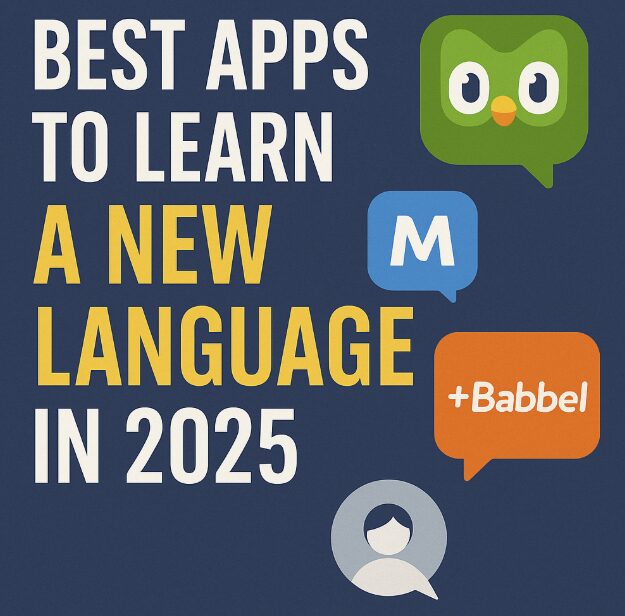Learning a new language has never been easier—or more accessible. In 2025, technology continues to revolutionize how we study, practice, and master foreign languages. Whether you’re preparing for a move abroad, trying to become more competitive in your career, or just learning for fun, there’s an app out there that fits your goals and learning style.
But with so many options available on the market, it can be hard to know which apps are actually worth your time. Some focus on grammar and structure, others on speaking and listening. Some are great for beginners, while others help you reach fluency. To help you decide, here’s a detailed look at the best language learning apps of 2025—and what makes each one special.

Duolingo – Still the Best for Casual Learners
Duolingo remains one of the most downloaded language apps in the world for good reason. It’s free, visually engaging, and gamified to keep you coming back. The app offers bite-sized lessons in more than 40 languages, and new features in 2025 include adaptive difficulty and personalized lesson paths based on your strengths and weaknesses.
Its strength lies in vocabulary and basic sentence structure. You won’t become fluent using Duolingo alone, but it’s a great way to build daily habits and start recognizing key words and grammar patterns.
Duolingo now includes cultural notes, speaking challenges, and improved speech recognition, making it more well-rounded than ever. For many casual learners, it’s a perfect entry point.
Try it here: Duolingo
Babbel – Best for Real-World Conversations
Babbel takes a more structured, curriculum-based approach than Duolingo. It’s ideal if you’re planning to travel, study, or live abroad and want to learn useful phrases for everyday situations. Lessons are short but focused, teaching vocabulary in context and guiding you through grammar step-by-step.
Babbel now offers live tutoring add-ons and AI-generated review sessions that target your weak points. It’s also one of the few apps with regional pronunciation guides, helping you understand how Spanish from Spain differs from that of Mexico or Argentina.
Babbel’s courses are built by language teachers and linguists, and it shows. While not free, its subscription model is affordable and worth it if you’re serious about learning to speak confidently.
Explore Babbel: https://www.babbel.com
Memrise – Best for Immersive Vocabulary Practice
Memrise blends spaced repetition with native speaker videos, helping you learn vocabulary and expressions that real people actually use. Its video-based content stands out, allowing you to hear and see native speakers in natural environments—from restaurants to streets to classrooms.
The app is especially strong for listening comprehension and vocabulary retention. In 2025, Memrise added “AI Tutor Mode” that lets you practice speaking in simulated conversations with an AI partner, making it feel like you’re chatting with a local.
If your goal is to understand how a language sounds in everyday life and expand your vocabulary fast, Memrise is a great pick.
Learn more: Memrise
Busuu – Best for Personalized Learning Plans
Busuu combines AI technology with community-based learning. It allows you to set specific goals (like passing a CEFR level test) and builds a personalized curriculum to help you achieve them. The app also features a large community of native speakers who can review your written or spoken exercises.
Its strength lies in structure. Grammar explanations are clear, and writing tasks help you think in full sentences instead of just matching flashcards. Busuu Premium now includes official certification tests and live lessons with native tutors.
In 2025, Busuu introduced smart feedback tools using natural language processing, helping you get corrections faster and more accurately.
Try Busuu: https://www.busuu.com
LingoDeer – Best for Asian Languages
LingoDeer was originally built for learning Korean, Japanese, and Chinese—and it still shines in those areas. While most mainstream apps struggle with complex writing systems and grammar structures, LingoDeer handles them smoothly with detailed explanations and culturally relevant examples.
The lessons feel like real language classes, and grammar is introduced clearly and logically. If you’re trying to learn an East Asian language from scratch, this app should be one of your top choices.
It now supports spaced repetition, writing practice, and audio from native speakers to improve pronunciation and listening skills.
Check it out: https://www.lingodeer.com
HelloTalk – Best for Language Exchange and Community
Sometimes the best way to learn a language is by talking to someone who already speaks it. HelloTalk connects learners from all over the world and helps them practice through real-time text, voice messages, and even calls. You can correct each other’s sentences and exchange language tips.
The app is built like a mix between a messaging platform and a social network. It’s ideal if you want to practice casual conversation, learn slang, or immerse yourself in the cultural context of a language.
In 2025, HelloTalk added voice-to-text translation, grammar filters, and integrated AI to help moderate exchanges and suggest better phrasing.
Download HelloTalk: https://www.hellotalk.com
Pimsleur – Best for Audio-Only Learners
If you’re more of an auditory learner or spend a lot of time commuting, Pimsleur might be the best fit. It focuses on audio-based learning, teaching you through conversations, repetition, and recall without ever having to look at a screen.
Pimsleur is especially good for pronunciation and conversational flow. The method has been around for decades and continues to evolve, now offering mobile-friendly formats, offline access, and even Alexa integration.
While it lacks visual content, it’s perfect for people who learn best by listening and speaking.
Explore Pimsleur: https://www.pimsleur.com
Choosing the Right App Based on Your Language Goals
Not every app fits every learner. Your choice depends on your goals, preferred learning style, and the language you’re studying.
Want to casually pick up a language for travel? Start with Duolingo or Memrise.
Looking for structured, grammar-based learning? Babbel or Busuu is ideal.
Focusing on Korean, Japanese, or Chinese? LingoDeer is your best bet.
Prefer to talk with real people? Try HelloTalk.
Need audio learning for long commutes? Go with Pimsleur.
Also, consider combining two apps. For example, use Duolingo for daily vocabulary and HelloTalk for live conversation. Many learners find that a mix of apps keeps motivation high and learning balanced.
Language learning takes time, consistency, and a bit of trial and error. But with the right tools—and a little curiosity—you’ll be surprised at how far you can go.
